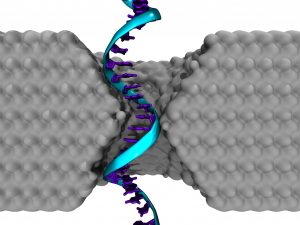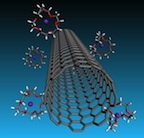Science
Penn Research Makes Advance in Nanotech Gene Sequencing Technique

An illustration of a single-stranded DNA homopolymer translocating through a silicon nitride nanopore.
- Read more
- 483 reads
NASA's Fermi, Swift See 'Shockingly Bright' Burst

The maps in this animation show how the sky looks at gamma-ray energies above 100 million electron volts (MeV) with a view centered on the north galactic pole. The first frame shows the sky during a three-hour interval prior to GRB 130427A. The second frame shows a three-hour interval starting 2.5 hours before the burst, and ending 30 minutes into the event. The Fermi team chose this interval to demonstrate how bright the burst was relative to the rest of the gamma-ray sky. This burst was bright enough that Fermi autonomously left its normal surveying mode to give the LAT instrument a better view, so the three-hour exposure following the burst does not cover the whole sky in the usual way.
- Read more
- 331 reads
'Going negative' pays for nanotubes: Rice University lab finds possible keys to better nanofibers, films

Crown ether “cages” trap potassium ions but leave nanotubes with a repellant negative charge in solutions that will be valuable for forming very strong, highly conductive carbon nanotube fibers. The Rice University discovery appears in ACS Nano.
- Read more
- 367 reads
How graphene and friends could harness the Sun’s energy

- Read more
- 513 reads
China Receives US$95 Million Grant to End Production of Ozone-Depleting Global-Warming Gases to help Meet its Targets under the Montreal Protocol
China, the world's largest producer of hydrochlorofluorocarbons (HCFC), received a US $95 million grant on April 23, 2013 to help reduce its production of HCFCs. These substances, used primarily in refrigeration and air-conditioning and in the manufacture of foam products, deplete the ozone layer and exacerbate climate change. The grant is from the Multilateral Fund for the Implementation of the Montreal Protocol on Substances that Deplete the Ozone Layer, which provides the funds in exchange for verified annual reductions of HCFC production levels.
- Read more
- 360 reads
'Tis the Season -- for Plasma Changes at Saturn

This is an artist's concept of the Saturnian plasma sheet based on data from Cassini magnetospheric imaging instrument. It shows Saturn's embedded "ring current," an invisible ring of energetic ions trapped in the planet's magnetic field.
- Read more
- 324 reads
'Going negative' pays for nanotubes: Rice University lab finds possible keys to better nanofibers, films

Crown ether “cages” trap potassium ions but leave nanotubes with a repellant negative charge in solutions that will be valuable for forming very strong, highly conductive carbon nanotube fibers. The Rice University discovery appears in ACS Nano.
- Read more
- 366 reads
Injectable Nano-Network Controls Blood Sugar in Diabetics for Days at a Time

The nano-network releases insulin in response to changes in blood sugar.
- Read more
- 373 reads
NASA Study Projects Warming-Driven Changes in Global Rainfall

Model simulations spanning 140 years show that warming from carbon dioxide will change the frequency that regions around the planet receive no rain (brown), moderate rain (tan), and very heavy rain (blue). The occurrence of no rain and heavy rain will increase, while moderate rainfall will decrease.
- Read more
- 390 reads
An Anarchic Region of Star Formation

The Danish 1.54-metre telescope located at ESO’s La Silla Observatory in Chile has captured a striking image of NGC 6559, an object that showcases the anarchy that reigns when stars form inside an interstellar cloud.
- Read more
- 508 reads
Human Rights
Fostering a More Humane World: The 28th Eurasian Economic Summi

Conscience, Hope, and Action: Keys to Global Peace and Sustainability

Ringing FOWPAL’s Peace Bell for the World:Nobel Peace Prize Laureates’ Visions and Actions

Protecting the World’s Cultural Diversity for a Sustainable Future

Puppet Show I International Friendship Day 2020

